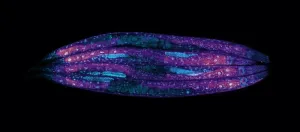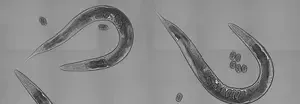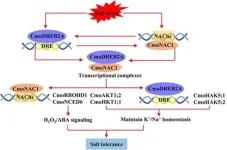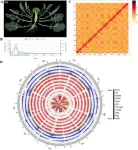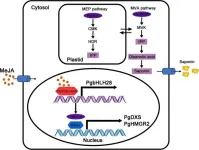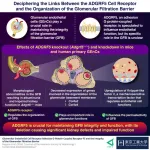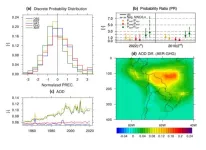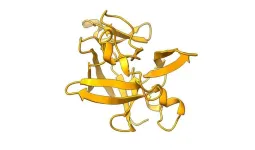(Press-News.org) Why do some people live for longer than others? The genes in our DNA sequence are important, helping avoid disease or maintain general health, but differences in our genome sequence alone explain less than 30% of the natural variance of human life expectancy.
Exploring how ageing is influenced at the molecular level could shed light on lifespan variation, but generating data at the speed, scale and quality necessary to study this in humans is unfeasible. Instead, researchers turn to worms (Caenorhabditis elegans). Humans share a lot of biology with these small creatures, who also have a large, natural variation in lifespan.
Researchers at the Centre for Genomic Regulation (CRG) observed thousands of genetically identical worms living in a controlled environment. Even when diet, temperature and exposure to predators and pathogens are the same for all worms, many individuals continue to live for a longer or shorter period of time than the average.
The study traced the primary source of this variation to changes in the mRNA content in germline cells (those involved in reproduction) and somatic cells (the cells forming the body). The mRNA balance between the two types of cells is disrupted, or ‘decouples’, over time, causing ageing to run faster in some individuals than others. The findings are published today in the journal Cell.
The study also found that the magnitude and speed of the decoupling process is influenced by a group of at least 40 different genes. These genes play many different roles in the body ranging from metabolism to the neuroendocrine system. However, the study is first to show they all interact to make some individuals live longer than others.
Knocking down some of the genes extended a worm’s lifespan, while knocking down others shortened it. The findings suggest a surprising possibility: the natural differences seen in ageing worms might reflect randomness in the activity of many different genes, making it look as if individuals have been exposed to knockdowns of many different genes.
“Whether a worm lives to day 8 or day 20 is down to seemingly random differences in the activity of these genes. Some worms appear to be simply lucky, in that they have the right mix of genes activated at the right time,” says Dr. Matthias Eder, first author of the paper and researcher at the Centre for Genomic Regulation.
Knocking down three genes – aexr-1, nlp-28, and mak-1 – had a particularly dramatic effect on lifespan variance, reducing the range from around 8 days to just 4. Rather than prolonging the lives of all individuals uniformly, removing any one of these genes drastically increased the life expectancy of worms on the low end of the spectrum, while the life expectancies of the longest-lived worms remained more or less unchanged.
The researchers observed the same effects on healthspan, the period of life spent healthy, rather than simply how long an individual is physically alive. The researchers measured this by studying how long the worms maintain vigorous movement. Knocking down just one of the genes was enough to disproportionately improving healthy ageing in worms on the low end of the healthspan spectrum.
“This isn’t about creating immortal worms, but rather making ageing a more equitable process than it currently is – a fairer game for all. In a way we’ve doing what doctors do, which is take worms that would die sooner than their peers and make them healthier, helping them live closer to their maximum potential life expectancy. But we're doing it by targeting basic biological mechanisms of aging, not just treating sick individuals. It’s essentially making a population more homogeneous and more long lived to boot,” says Dr. Nick Stroustrup, senior author of the study and Group Leader at the Centre for Genomic Regulation.
The study doesn’t address why knocking down the genes doesn't seem to negatively affect the worm's health. “Several genes could interact to provide built-in redundancy after a certain age. It could also be that the genes aren’t needed for individuals living in benign, safe conditions where the worms are kept in the lab. In the harsh environment of the wild, these genes might be more critical for survival. These are just some of the working theories,” says Dr. Eder.
The researchers made their findings by developing a method which measures RNA molecules in different cells and tissues, combining it with the ‘Lifespan Machine’, a device which follows the entire lives of thousands of nematodes at once. The worms live in a petri dish housed inside the machine under the watchful eye of a scanner. The device images nematodes once per hour, gathering lots of data about their behaviour. The researchers have plans to build a similar machine to study the molecular causes of ageing in mice, which have a biology that more closely resembles that of humans.
END
How to make ageing a ‘fairer game’ for all wormkind
Researchers dramatically extend life expectancy of animals while trading weak, frail old age for vigorous golden years
2024-06-21
ELSE PRESS RELEASES FROM THIS DATE:
Supporting the right small changes can have big impacts
2024-06-21
Small changes in our everyday actions can trigger significant, rapid societal shifts especially when it comes to climate action. A new IIASA-led study highlights the importance of analyzing these dynamics with a comprehensive framework to harness their full potential for reducing carbon emissions.
Making small changes in how we live day-to-day can quickly create significant changes in society, especially in ways that benefit the environment. This idea is captured in the term social tipping points.
According to the authors of a new paper just published in the journal One Earth, social tipping points are crucial for speeding up efforts to reduce carbon emissions. These points occur when ...
Grafted cucumbers get a boost: pumpkin's secret to withstanding salinity
2024-06-21
A pivotal study has discovered a genetic synergy between pumpkin and cucumber that fortifies the latter's resilience against salinity. The research illuminates the role of the CmoDREB2A transcription factor from pumpkin, which, when interacted with cucumber's CmoNAC1, forms a regulatory loop that enhances salt tolerance. This breakthrough could be key to developing crops that thrive in saline soils, safeguarding agricultural productivity.
Soil salinity, a silent blight on global agriculture, affects an estimated 10% of the world's arable land, leading to significant crop ...
Unlocking broccoli's genome: key to enhanced health benefits
2024-06-21
A detailed genomic study of broccoli has revealed the genetic foundations for the production of glucosinolates (GSLs), compounds celebrated for their health benefits, including anti-carcinogenic properties. By assembling a high-quality chromosome-level genome, researchers identified key genes involved in GSL biosynthesis. These findings offer critical insights for future genetic studies and the development of Brassica crops with enhanced nutritional value, paving the way for improved health benefits from these widely consumed vegetables.
Broccoli is renowned for its health benefits, primarily due to its rich glucosinolate (GSL) content, which has anti-carcinogenic ...
New insights into methyl jasmonate-induced saponin biosynthesis in balloon flower
2024-06-21
A cutting-edge study has pinpointed the PgbHLH28 gene as a crucial catalyst in the methyl jasmonate-induced (MeJA-induced) saponin biosynthesis in Platycodon grandiflorus. This genetic insight could significantly bolster the production of saponins, which are beneficial in combating cerebrovascular diseases and COVID-19, offering a novel therapeutic avenue in medicinal plant cultivation.
Platycodon grandiflorus, commonly known as balloon flower, is renowned for its medicinal properties, primarily due to its rich saponin content. Saponins are known for ...
Unraveling the role of ADGRF5: Insights into kidney health and function
2024-06-21
Glomerulus, the fundamental filtering unit of the kidney, is an intricate network of capillaries — small blood vessels that regulate the movement of ions, water, and metabolites while maintaining impermeability to essential macromolecules such as proteins. The selectively permeable capillary wall, known as the glomerular filtration barrier (GFB), consists of three main components: glomerular endothelial cells (GEnCs), the glomerular basement membrane, and podocytes. GEnCs line the inner surface of the capillary wall and are covered by a thin layer of glycoproteins and other carbohydrate-based moieties.
Adhesion G-protein-coupled ...
JMIR Dermatology accepted for MEDLINE indexing
2024-06-21
(Toronto, June 21, 2024) JMIR Publications is pleased to announce that JMIR Dermatology (JMIR Derm) has been accepted for inclusion in MEDLINE, which is the U.S. National Library of Medicine's premier bibliographic database.
JMIR Dermatology was previously already indexed in PubMed, but MEDLINE is a more selective subset of PubMed, consisting of the top 5200 biomedical journals, and indexing in MEDLINE also means that articles are now also indexed with NLM Medical Subject Headings (MeSH terms) and other metadata.
Selection for MEDLINE is a result of a thorough review of the ...
Reduced infections seen in CLL and NHL patients undergoing immunoglobulin testing and replacement therapy
2024-06-21
(WASHINGTON, June 21, 2024) – Patients with chronic lymphocytic leukemia (CLL) and non-Hodgkin lymphomas (NHLs) who received frequent tests for immunoglobulin G (IgG) were less likely to experience severe infections compared with those who didn’t, according to a study published in Blood Advances. Moreover, only half of patients undergo such testing.
Patients with blood cancers such as CLL and NHL are at elevated risk for potentially life-threatening infections due to low blood levels of immunoglobulins — proteins ...
Human activity: A double-edged sword in the face of drought
2024-06-21
Earth and environmental scientists reported that as human socio-economic activities increase, greenhouse gas emissions will rise, leading to more frequent extreme weather events such as droughts and floods. However, a research team from Pohang University of Science and Technology (POSTECH) has published a study suggesting that anthropogenic greenhouse gases might actually mitigate droughts, offering a new perspective on the impact of human activities on nature.
Professor Jonghun Kam from the Division of Environmental Science and Engineering at POSTECH ...
Portfolio performance in financial management: apraize, analyze, act.
2024-06-21
Co-authored by Pascal François (HEC Montreal) and Georges Hubner (University of Liège), both professors of finance, The Complete Guide to Portfolio Performance: Appraise, Analyse, Act, just published by Wiley, is a comprehensive guide to all aspects of financial portfolio performance. The book explores the essential topics of portfolio performance measurement in a realistic and rigorous way, with usable content clearly illustrated by practical examples that demonstrate the application of the concepts discussed.
Portfolio management is a complex field, requiring in-depth expertise ...
Landmark Nature Medicine study reports promising new treatment reduces suffering in Sanfilippo syndrome
2024-06-21
As a neurodegenerative disease characterized by childhood onset dementia, Sanfilippo syndrome causes immense suffering in many ways, including pain, loss of speech, extreme agitation, and distress, gastrointestinal symptoms, and profound sleep disturbance. With no approved treatment, clinical specialists have had few options to help alleviate this suffering until now. A groundbreaking clinical trial collaboration between study lead and principal investigator Lynda Polgreen, MD, MS, Investigator at The Lundquist Institute for Biomedical Innovation at Harbor-UCLA (TLI) and Associate ...
LAST 30 PRESS RELEASES:
Electrons lag behind the nucleus
From fungi to brain cells: one scientist's winding path reveals how epigenomics shapes neural destiny
Schizophrenia and osteoporosis share 195 genetic loci, highlighting unexpected biological bridges between brain and bone
Schizophrenia-linked genetic variant renders key brain receptor completely unresponsive to both natural and therapeutic compounds
Innovative review reveals overlooked complexity in cellular energy sensor's dual roles in Alzheimer's disease
Autism research reframed: Why heterogeneity is the data, not the noise
Brazil's genetic treasure trove: supercentenarians reveal secrets of extreme human longevity
The (metabolic) cost of life
CFRI special issue call for papers: New Frontiers in Sustainable Finance
HKU Engineering scholar demonstrates the smallest all-printed infrared photodetectors to date
Precision empowerment for brain "eavesdropping": CAS team develops triple-electrode integrated functional electrode for simultaneous monitoring of neural signals and chemical transmitters during sleep
Single-capillary endothelial dysfunction resolved by optoacoustic mesoscopy
HKU three research projects named among ‘Top 10 Innovation & Technology News in Hong Kong 2025’ showcasing excellence in research and technology transfer
NLRSeek: A reannotation-based pipeline for mining missing NLR genes in sequenced genomes
A strand and whole genome duplication–aware collinear gene identification tool
Light storage in light cages: A revolutionary approach to on-chip quantum memories
Point spread function decoupling in computational fluorescence microscopy
BacPhase: Long-insert paired-end sequencing for bin marker construction and genome phasing
GmWOX1 regulates the mediolateral polarity of compound leaves in soybean
ChargeFabrica: An open-source simulation tool that aims to accelerate search for high performance perovskite solar cells
High levels of ADAR overexpression induce abundant and stochastic off-target RNA editing in rice protoplasts
On-demand upgraded recycling of polyethylene and construction of sustainable multifunctional materials based on the "LEGO" strategy
New "Stomata in-sight" system allows scientists to watch plants breathe in real-time
Anorexia nervosa may result in long-term skeletal muscle impairment
Narrative-based performance reviews deemed fairest by employees
New insights reveal how advanced oxidation can tackle emerging water pollutants
New review shows how biomass can deliver low-carbon gaseous fuels at scale
Climate change is quietly rewriting the world’s nitrogen cycle, with high stakes for food and the environment
Study finds SGLT-2 inhibitors linked to lower risk of diabetic foot nerve damage
Microbes may hold the key to brain evolution
[Press-News.org] How to make ageing a ‘fairer game’ for all wormkindResearchers dramatically extend life expectancy of animals while trading weak, frail old age for vigorous golden years
